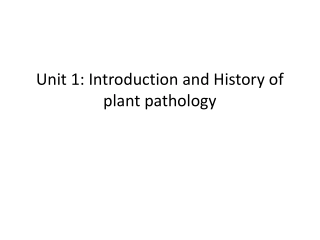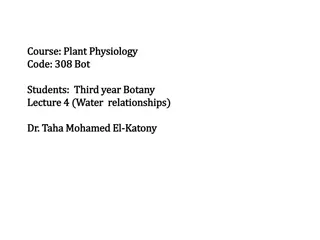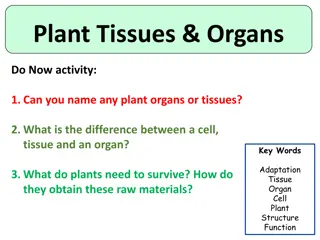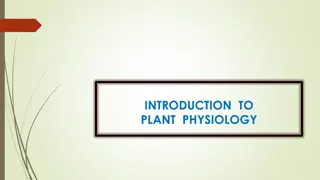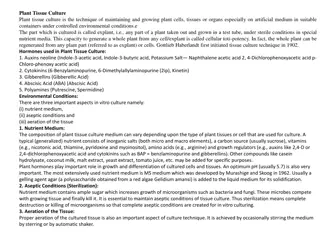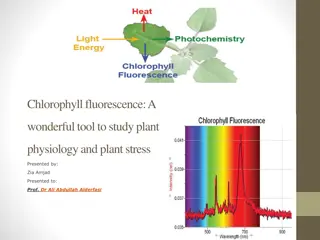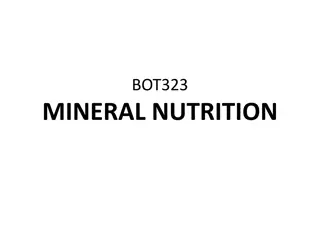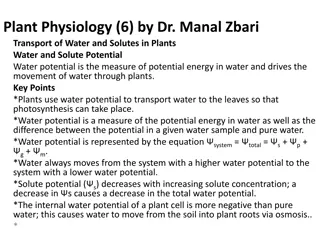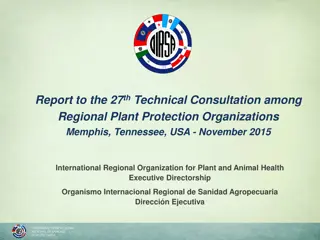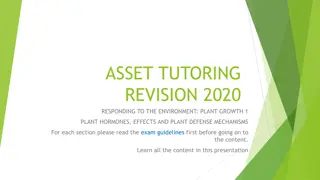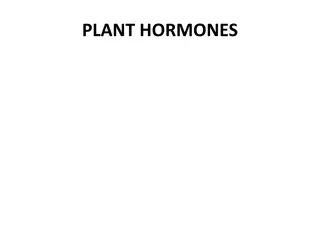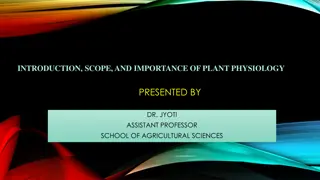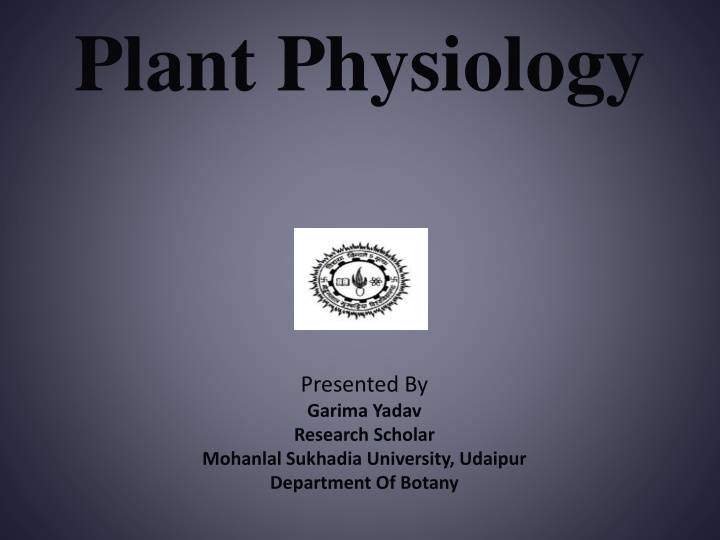
Importance of Abscisic Acid in Plant Physiology
Explore the significance of abscisic acid (ABA) in plant physiology, its role in seed dormancy, stress responses, and interactions with other hormones. Learn about ABA synthesis, distribution in plants, and its diverse physiological functions.
Download Presentation

Please find below an Image/Link to download the presentation.
The content on the website is provided AS IS for your information and personal use only. It may not be sold, licensed, or shared on other websites without obtaining consent from the author. If you encounter any issues during the download, it is possible that the publisher has removed the file from their server.
You are allowed to download the files provided on this website for personal or commercial use, subject to the condition that they are used lawfully. All files are the property of their respective owners.
The content on the website is provided AS IS for your information and personal use only. It may not be sold, licensed, or shared on other websites without obtaining consent from the author.
E N D
Presentation Transcript
Plant Physiology Presented By Garima Yadav Research Scholar Mohanlal Sukhadia University, Udaipur Department Of Botany
ABSCISIC ACID The hormone abscisic acid (ABA) is represented by a single 15-carbon sesquiterpene. The name is based on the once held belief that it was involved in the abscission of leaves and other organs. In 1953, Bennet-Clark and Kefford reported that plant extracts contained, in addition to IAA, a substance that inhibited growth of coleoptile sections, which they called inhibitor . large amounts of inhibitor could be isolated from axillary buds and the outer layer of dormant potato tuber led Kefford to suggest that it was involved in apical dominance and maintaining dormancy in potatoes. Other investigators reported the occurrence of inhibitors in buds and leaves that appeared to correlate with the onset of dormancy in woody plants. In 1964, P. F. Waring proposed the term dormin for these endogenous, dormancy-inducing substances.
substances that accelerated abscission were isolated from senescing leaves of bean and from cotton and lupin fruits. These substances would accelerate abscission when applied to excised abscission zones and were called abscission II. These several lines of study came to a head in the mid-1960s when three laboratories independently reported the purification and chemical characterization of abscisin II, inhibitor , and dormin. All three substances proved to be chemically identical. The name abscisic acid and abbreviation ABA were recommended by International Conference on Plant Growth Substances, which met in Ottawa in the 1967. Abscisic acid has been found to be a ubiquitous plant hormone in vascular plants. It has been detected in mosses but appears to be absent in liverworts. Several genera of fungi make ABA as a secondary metabolite (Milborrow 2001). Within the plant, ABA has been detected in every major organ or living tissue from the root cap to the apical bud. ABA is synthesized in almost all cells that contain chloroplasts or amyloplasts. Abscisic acid was found predominantly in mature, green leaves, especially in water- stressed plants. Abscisic acid is synthesized in mesophyll cells, guard cells, and vascular tissue. ABA precursors originate in chloroplasts but ABA itself is formed in the cytoplasm.
Physiological role of ABA Abscisic acid plays primary regulatory roles in the initiation and maintenance of seed and bud dormancy and in the plant s response to stress, particularly water stress. In addition, ABA influences many other aspects of plant development by interacting, usually as an antagonist, with auxin, cytokinin, gibberellin, ethylene, and brassinosteroids. The primary functions of ABA are (1) prohibiting precocious germination and promoting dormancy in seeds and (2) inducing stomatal closure and the production of molecules that protect cells against desiccation in times of water stress. ABA has also been implicated in other developmental responses, including the induction of storage protein synthesis in seeds, heterophylly (leaves of different shape on the same plant), initiation of secondary roots, flowering, and senescence.
Abscisic acid regulates embryo maturation and seed germination. The development of embryos and subsequent germination of the seed is characterized by often dramatic changes in hormone levels. In the early stages of embryogenesis, there is little or no detectable ABA. It is only during the latter stages of embryo development, as GA and IAA levels begin to decline, that ABA levels begin to rise. ABA levels generally peak during the maturation stage, when seed volume and dry weight also reach a maximum, and then return to lower levels in the dry seed. Maturation of the embryo is characterized by cessation of embryo growth, accumulation of nutrient reserves in the endosperm, and the development of tolerance to desiccation. One of the functions of a seed, of course, is to disperse the population and ensure survival of the species through unfavorable conditions. A seed would be of little value if the embryo did not enter dormancy but continued to grow and establish a new plant before dispersal could occur. One function of ABA is to prevent such precocious germination, or vivipary, while the seed is still on the mother plant.
The relationship between ABA and precocious germination is clear. Vivipary can be chemically induced in maize by treatment of the developing ear at the appropriate time with fluridone, a chemical inhibitor of carotenoid biosynthesis. Since carotenoids and ABA share earl biosynthetic steps, fluridone inhibits biosynthesis of ABA as well. Fluridone-induced vivipary can be at least partially alleviated by application of exogenous ABA. Soybean embryos can be encouraged to germinate precociously by treatments such as washing or slow drying, both of which lower the endogenous ABA level. ABA also stimulates protein accumulation in the latter stages of soybean embryo development and is known to prevent GA-induced -amylase biosynthesis in cereal grains. All of these results establish a strong connection between ABA and seed maturation and/or prevention of precocious germination. ABA also initiates desiccation of the seed, although the mechanisms are unknown. This may involve ABA regulation of genes which encode proteins that are involved in desiccation tolerance.
ABA Promotes Leaf Senescenc Independently of Ethylene. Abscisic acid was originally isolated as an abscission- causing factor. However, it has since become evident that ABA stimulates abscission of organs in only a few species and that the primary hormone causing abscission is ethylene. On the other hand, ABA is clearly involved in leaf senescence, and through its promotion of senescence it might indirectly increase ethylene formation and stimulate abscission. Leaf senescence has been studied extensively, and the anatomical, physiological, and biochemical changes that take place during this process . Leaf segments senesce faster in darkness than in light, and they turn yellow as a result of chlorophyll breakdown. In addition, the breakdown of proteins and nucleic acids is increased by the stimulation of several hydrolases. ABA greatly accelerates the senescence of both leaf segments and attached leaves
Abscisic acid mediates response to water stress. Plants generally respond to acute water deficits by closing their stomata in order to match transpirational water loss from the leaf surface with the rate at which water can be resupplied by the roots. Since the discovery of ABA in the late 1960s, it has been known to have a prominent role in stomatal closure during water stress. In fact, ABA has long been recognized as antitranspirant because of its capacity to induce stomatal closure and thus reduce water loss through transpiration. ABA accumulates in water-stressed (that is, wilted) leaves and exogenous application of ABA is a powerful inhibitor of stomatal opening. According to current thinking, the initial detection of water stress in leaves is related to its effects on photosynthesis. Inhibition of electron transport and photophosphorylation in the chloroplasts would disrupt proton accumulation in the thylakoid lumen and lower the stroma pH. At the same time, there is an increase in the pH of the apoplast surrounding the mesophyll cells. The resulting pH gradient stimulates a release of ABA from the mesophyll cells into the apoplast, where it can be carried in the transpiration stream to the guard cells
There is recent evidence that ABA may also have a role in lateral or secondary root development. The initiation and development of lateral roots is known to be primarily under the control of auxin, but lateral root development can be inhibited by ABA if the hormone is applied during early stages of lateral root development, before the lateral root meristem becomes organized. Endogenous ABA may normally inhibit or delay flowering in Arabidopsis. Further support comes from the discovery that a gene (FCA) previously known to be involved in controlling the time of flowering also has the properties of an abscisic acid receptor.
ETHYLENE Ethylene is another class of hormones with a single representative. Ethylene is a simple gaseous hydrocarbon with the chemical structure H2C=CH2. Ethylene is apparently not required for normal vegetative growth, although it can have a significant impact on the development of roots and shoots. Ethylene appears to be synthesized primarily in response to stress and may be produced in large amounts by tissues undergoing senescence or ripening. Ethylene is commonly used to enhance ripening in bananas and other fruits that are picked green for shipment. Ethylene is frequently produced when high concentrations of auxins are supplied to plant tissues and many of the inhibitory responses to exogenously applied auxin appear to be due to auxin-stimulated ethylene release rather than auxin itself.
Ethylene occurs in all plant organsroots, stems, leaves, bulbs, tubers, fruits, seeds, and so on although the rate of production may vary depending on the stage of development. Ethylene production will also vary from tissue to tissue within the organ, but is frequently located in peripheral tissues. In peach and avocado seeds, for example, ethylene production appears to be localized primarily in the seed coats, while in tomato fruit and mung bean hypocotyls it originates from the epidermal regions. The off- gassing of ethylene by natural vegetation is also a significant source of atmospheric volatile organic carbon (VOC). Ethylene is synthesized from the amino acid methionine.
In general, meristematic regions and nodal regions are the most active in ethylene biosynthesis. However, ethylene production also increases during leaf abscission and flower senescence, as well as during fruit ripening. Any type of wounding can induce ethylene biosynthesis, as can physiological stresses such as flooding, chilling, disease, and temperature or drought stress. Ethylene is the simplest known olefin (its molecular weight is 28), and it is lighter than air under physiological conditions. It is flammable and readily undergoes oxidation. Ethylene can be oxidized to ethylene oxide. In most plant tissues, ethylene can be completely oxidized to CO2. Ethylene is released easily from the tissue and diffuses in the gas phase through the intercellular spaces and outside the tissue. Gymnosperms and lower plants, including ferns, mosses, liverworts, and certain cyanobacteria, all have shown the ability to produce ethylene. Ethylene production by fungi and bacteria contributes significantly to the ethylene content of soil. Certain strains of the common enteric bacterium Escherichia coli and of yeast (a fungus) produce large amounts of ethylene from methionine.
The effect of ethylene on plants was originally described by Dimitry Nikolayevich Neljubow, a graduate student in Russia in 1886, who found that abnormal growth of dark- grown pea seedlings could be traced an element, that were later termed the triple response: reduced stem elongation, increased lateral growth (swelling), and abnormal, horizontal growth. When the plants were allowed to grow in fresh air, they regained their normal morphology and rate of growth. Neljubov identified ethylene, which was present in the laboratory air from coal gas, as the molecule causing the response. A number of similar reports appeared in the early 1930s, showing that volatile emanations from apples caused epinasty in tomato seedlings and respiratory changes associated with the ripening process. In 1934, R. Gane provided indisputable evidence that the volatile substance was ethylene.
Physiological role of Ethylene As we have seen, ethylene was discovered in connection with its effects on seedling growth and fruit ripening. It has since been shown to regulate a wide range of responses in plants, including seed germination, cell expansion, cell differentiation, flowering, senescence, and abscission.
Ethylene Promotes the Ripening of Some Fruits. Ethylene is known primarily for its promotion of fruit ripening and senescence. Ethylene control of fruit development has been studied extensively in tomato, which is a climacteric fruit. During the development of climacteric fruits there is a characteristic developmentally regulated burst in respiration called the climacteric rise. Ethylene Promotes the Elongation Growth of Submerged Aquatic Species: Ethylene has been shown to stimulate elongation of stems, petioles, roots, and floral structures of aquatic and semiaquatic plants. The effect is particularly noted in aquatic plants because submergence reduces gas dispersion and thus maintains higher internal ethylene levels. In rice, ethylene is ineffective in the presence of saturating levels of gibberellins, which also promotes stem elongation. Moreover, ethylene promotes gibberellin synthesis in rice and the elongation effect can be blocked with antigibberellins, which suggests that gibberellin mediates this ethylene effect. root and shoot elongation in nonaquatic plants such as peas (Pisum sativum) is inhibited by ethylene.
Leaf Epinasty Results When ACC from the Root Is Transported to the Shoot Ethylene stimulates many inhibitory and abnormal growth responses such as the swelling of stem tissues and the downward curvature of leaves, or epinasty. Leaf epinasty occurs because of excessive cell elongation on the adaxial (i.e., upper) side of the petiole. Epinasty is a common response to water logging of flood-sensitive plants such as tomato (Lycopersicum) and is actually a response to anoxia in the region of the roots. The more vertical orientation of epinastic leaves reduces the absorption of solar energy and, consequently, transpiration water loss. This helps to bring water loss more into line with reduced capacity for water uptake in plants suffering root anoxia. A role for ethylene has also been noted for promotion of seed germination, inhibition of bud break, reduced apical dominance, fruit ripening, cell death, and pathogen responses. Ethylene can be a problem in commercial greenhouse that are heated with gas-fired heating systems
Ethylene Induces Lateral Cell Expansion. At concentrations above 0.1 L L 1, ethylene changes the growth pattern of seedlings by reducing the rate of elongation and increasing lateral expansion, leading to swelling of the region below the hook. These effects of ethylene are common to growing shoots of most dicots, forming part of the triple response. In Arabidopsis, the triple response consists of inhibition and swelling of the hypocotyl, inhibition of root elongation, and exaggeration of the apical hook. The Hooks of Dark-Grown Seedlings Are Maintained by Ethylene Production Etiolated dicot seedlings are usually characterized by a pronounced hook located just behind the shoot apex. This hook shape facilitates penetration of the seedling through the soil, protecting the tender apical meristem. Like epinasty, hook formation and maintenance result from ethylene-induced asymmetric growth. The closed shape of the hook is a consequence of the more rapid elongation of the outer side of the stem compared with the inner side. When the hook is exposed to white light, it opens because the elongation rate of the inner side increases, equalizing the growth rates on both sides. Red light induces hook opening, and far-red light reverses the effect of red, indicating that phytochrome is the photoreceptor involved in this process. A close interaction between phytochrome and ethylene controls hook opening. As long as ethylene is produced by the hook tissue in the dark, elongation of the cells on the inner side is inhibited. Red light inhibits ethylene formation, promoting growth on the inner side, thereby causing the hook to open.
Ethylene Breaks Seed and Bud Dormancy in Some Species. Seeds that fail to germinate under normal conditions (water, oxygen, temperature suitable for growth) are said to be dormant. Ethylene has the ability to break dormancy and initiate germination in certain seeds, such as cereals. In addition to its effect on dormancy, ethylene increases the rate of seed germination of several species. In peanuts (Arachis hypogaea), ethylene production and seed germination are closely correlated. Ethylene can also break bud dormancy, and ethylene treatment is sometimes used to promote bud sprouting in potato and other tubers.
Ethylene Induces the Formation of Roots and Root Hairs. Ethylene is capable of inducing adventitious root formation in leaves, stems, flower stems, and even other roots. Ethylene has also been shown to act as a positive regulator of root hair formation in several species . This relationship has been best studied in Arabidopsis, in which root hairs normally are located in the epidermal cells that overlie a junction between the underlying cortical cells (Dolan et al. 1994). In ethylene-treated roots, extra hairs form in abnormal locations in the epidermis; that is, cells not overlying a cortical cell junction differentiate into hair cells (Tanimoto et al. 1995). Seedlings grown in the presence of ethylene inhibitors (such as Ag+), as well as ethylene-insensitive mutants, display a reduction in root hair formation in response to ethylene. These observations suggest that ethylene acts as a positive regulator in the differentiation of root hairs.
Ethylene Induces Flowering in the Pineapple Family. Although ethylene inhibits flowering in many species, it induces flowering in pineapple and its relatives, and it is used commercially in pineapple for synchronization of fruit set. Flowering of other species, such as mango, is also initiated by ethylene. On plants that have separate male and female flowers (monoecious species), ethylene may change the sex of developing flowers. The promotion of female flower formation in cucumber is one example of this effect.
Ethylene Enhances the Rate of Leaf Senescence senescence is a genetically programmed developmental process that affects all tissues of the plant. Several lines of physiological evidence support roles for ethylene and cytokinins in the control of leaf senescence: Exogenous applications of ethylene or ACC (the precursor of ethylene) accelerate leaf senescence, and treatment with exogenous cytokinins delays leaf senescence . Enhanced ethylene production is associated with chlorophyll loss and color fading, which are characteristic features of leaf and flower senescence ; an inverse correlation has been found between cytokinin levels in leaves and the onset of senescence. Inhibitors of ethylene synthesis (e.g., AVG or Co2+) and action (e.g., Ag+ or CO2) retard leaf senescence. Taken together, the physiological studies suggest that senescence is regulated by the balance of ethylene and cytokinin. In addition, abscisic acid (ABA) has been implicated in the control of leaf senescence
Ethylene Has Important Commercial Uses Because ethylene regulates so many physiological processes in plant development, it is one of the most widely used plant hormones in agriculture. Auxins and ACC can trigger the natural biosynthesis of ethylene and in several cases are used in agricultural practice. Because of its high diffusion rate, ethylene is very difficult to apply in the field as a gas, but this limitation can be overcome if an ethylene-releasing compound is used. The most widely used such compound is ethephon, or 2- chloroethylphosphonic acid, which was discovered in the 1960s and is known by various trade names, such as Ethrel. Ethephon is sprayed in aqueous solution and is readily absorbed and transported within the plant. It releases ethylene slowly by a chemical reaction, allowing the hormone to exert its effects: Ethephon hastens fruit ripening of apple and tomato and degreening of citrus, synchronizes flowering and fruit set in pineapple, and accelerates abscission of flowers and fruits. It can be used to induce fruit thinning or fruit drop in cotton, cherry, and walnut. It is also used to promote female sex expression in cucumber, to prevent self-pollination and increase yield, and to inhibit terminal growth of some plants in order to promote lateral growth and compact flowering stems. Storage facilities developed to inhibit ethylene production and promote preservation of fruits have a controlled atmosphere of low O2 concentration and low temperature that inhibits ethylene biosynthesis. A relatively high concentration of CO2 (3 to 5%) prevents ethylene s action as a ripening promoter. Low pressure (vacuum) is used to remove ethylene and oxygen from the storage chambers, reducing the rate of ripening and preventing overripening. Specific inhibitors of ethylene biosynthesis and action are also useful in postharvest preservation. Silver (Ag+) is offensive odor of trans-cyclooctene precludes its use in agriculture. Currently, 1-methylcyclopropene (MCP) is being developed for use in a variety of postharvest applications

